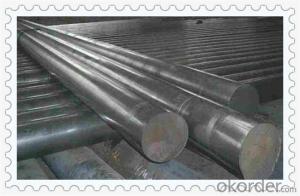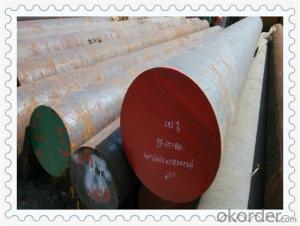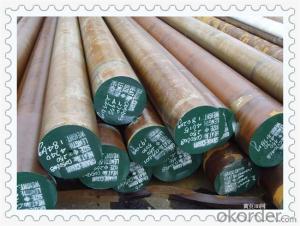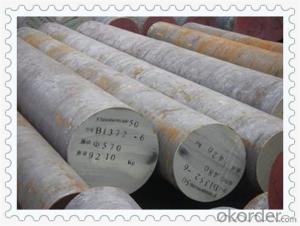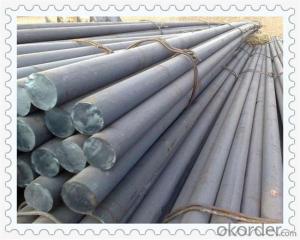12L14 Steel Free Cutting Steel Round Bar
- Loading Port:
- China main port
- Payment Terms:
- TT OR LC
- Min Order Qty:
- 5 m.t.
- Supply Capability:
- 100000 m.t./month
OKorder Service Pledge
OKorder Financial Service
You Might Also Like
Item specifice
12L14 Steel Free Cutting Steel Round Bar
Specifications
1. Material:12L14
2. Size: 0.2mm-16mm
3. Stable quality
4. Competitive price
We own the eight profassion engineers of high strength steel wire,and five QC to keep the products good quality so that in oversea marketing .we have been getting good reputation for over 10 years.
Next we introduce the products as follows:
1. Steel grade: 12L14; SUM24L.
2. Diameter: 0.2mm-16mm.
3. Application: machinery, mechanical parts, instruments, auto parts and so on.
4. Tolerance standard: h8; h9, h10; h11.
Chemical composition& Tolerance
| Grade | JIS | C | Si | Mn | P | S | Pb |
| 12L14 | SUM24L | 0.15max | 0.15-0.35 | 0.85-1.15 | 0.04-0.09 | 0.26-0.35 | 0.10-0.35 |
| S25CL | 0.22-0.28 | 0.15-0.35 | 0.30-0.6 | 0.03max | 0.035max | 0.10-0.35 | |
| S45CL | 0.42-0.48 | 0.15-0.35 | 0.60-0.9 | 0.03max | 0.035max | 0.10-0.35 | |
| 1215 | SUM23 | 0.09max | 0.75-1.05 | 0.04-0.09 | 0.26-0.35 | ||
| SUN25 | 0.15max | 0.90-1.40 | 0.07-0.12 | 0.30-0.40 | |||
| Tolerance | |||||||
| Range | H8 | H9(Round bar) | H10(Hexagonal bar) | H11 | H12 | ||
| <3mm | 0-0.014 | 0-0.025 | 0-0.040 | 0-0.060 | 0-0.10 | ||
| 3-6mm | 0-0.018 | 0-0.030 | 0-0.048 | 0-0.075 | 0-0.12 | ||
| 6-10mm | 0-0.022 | 0-0.036 | 0-0.058 | 0-0.090 | 0-0.15 | ||
| 10-18mm | 0-0.022 | 0-0.043 | 0-0.070 | 0-0.11 | 0-0.18 | ||
| 18-30mm | 0-0.033 | 0-0.052 | 0-0.084 | 0-0.13 | 0-0.21 | ||
| 30-50mm | 0-0.039 | 0-0.062 | 0-0.100 | 0-0.16 | 0-0.25 | ||

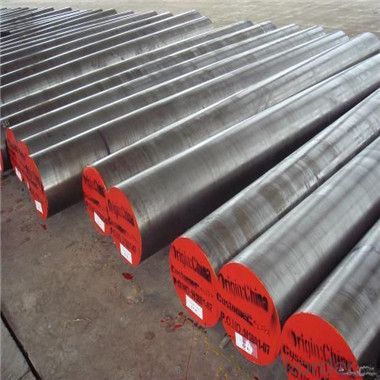

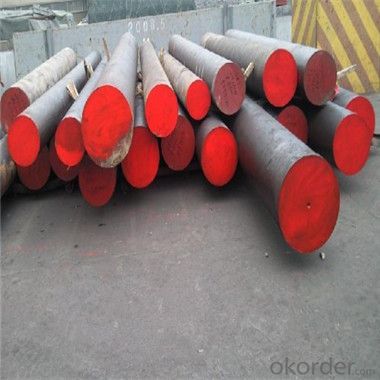
- Q:Can steel round bars be used for making propeller shafts?
- Yes, steel round bars can be used for making propeller shafts. Steel is a commonly used material for propeller shafts due to its strength, durability, and resistance to corrosion. Round bars, in particular, are often chosen for their shape, which provides optimal strength and load-bearing capabilities. The selection of steel grade and specific properties will depend on the requirements of the propeller shaft, such as the desired length, diameter, and torque capacity. Additionally, other factors like cost, weight, and manufacturability may also influence the choice of steel round bars for propeller shafts.
- Q:How can steel round bars be protected against rust?
- There are various ways to protect steel round bars from rust. One popular method involves applying a protective coating, like paint or a rust-resistant primer, which acts as a barrier between the steel and its surroundings, preventing moisture and oxygen from reaching the metal surface. Another effective approach is to galvanize the steel by immersing it in molten zinc. This creates a sacrificial barrier that shields the steel, even if it gets scratched or damaged. Maintaining the steel round bars is crucial in preventing rust. This involves keeping them clean and dry, as moisture is a major catalyst for rust formation. Regular inspections for rust or damage and prompt repairs are also important to prevent further corrosion. Storing the bars in a dry and well-ventilated area can help reduce the risk of rust. Elevating the bars off the ground or using moisture-absorbing materials, like silica gel packets, can provide additional protection against moisture buildup. Lastly, using corrosion inhibitors or rust-preventative oils can create a thin film on the surface that inhibits rust formation. By implementing these methods, steel round bars can be effectively shielded from rust, ensuring their durability and structural integrity.
- Q:What are the advantages of using nickel-aluminum alloy steel round bars?
- Nickel-aluminum alloy steel round bars offer numerous advantages. Firstly, they provide excellent resistance to corrosion, making them suitable for use in environments exposed to moisture, chemicals, or extreme temperatures. This resistance prolongs the lifespan of the bars and reduces the need for frequent maintenance or replacement. Secondly, these round bars demonstrate exceptional strength and toughness, making them ideal for structural applications requiring durability and reliability. Their high strength enables them to withstand heavy loads and impacts without deforming or breaking, ensuring the integrity of the structure. In addition, nickel-aluminum alloy steel round bars possess good heat resistance, allowing them to withstand high temperatures without losing their mechanical properties. This makes them suitable for applications involving heat or thermal cycling, while also maintaining their shape and strength under extreme temperature variations. Furthermore, these round bars exhibit excellent machinability, enabling easy cutting, drilling, and shaping into various forms. This versatility reduces manufacturing time and costs, and also facilitates customization to meet specific design requirements. Moreover, nickel-aluminum alloy steel round bars have good weldability, allowing them to be easily joined to other materials without compromising their mechanical properties. This enables the construction of complex structures or assemblies that require the combination of different materials. In summary, the advantages of nickel-aluminum alloy steel round bars include corrosion resistance, high strength and toughness, heat resistance, good machinability, and weldability. These properties make them a reliable and versatile choice for a wide range of applications in industries such as aerospace, automotive, construction, and marine.
- Q:What is the resistance to wear of a steel round bar?
- The resistance to wear of a steel round bar can vary depending on various factors, such as the specific type of steel used, its hardness, surface finish, and any protective coatings or treatments applied to it. Generally, steel is known for its excellent resistance to wear and can withstand abrasion and friction quite well. Steel is inherently a durable and strong material, which makes it resistant to wear caused by repetitive or prolonged contact with other surfaces. Its hardness and strength allow it to resist deformation, chipping, or cracking, even under high-stress conditions. This property makes steel round bars suitable for applications that involve heavy loads, constant movement, or abrasive environments. However, it is important to note that the resistance to wear of a steel round bar can still be influenced by external factors. For example, if the steel round bar is exposed to corrosive environments or subjected to improper handling or maintenance, its wear resistance may be compromised. In such cases, corrosion or surface damage can occur, leading to a decrease in the overall resistance to wear. To enhance the wear resistance of a steel round bar, additional measures can be taken. For instance, heat treatments like quenching and tempering can be applied to improve the hardness and strength of the steel, thereby increasing its wear resistance. Additionally, coatings such as chrome plating or nitriding can be used to provide an extra layer of protection against wear, reducing friction and improving the overall lifespan of the steel round bar. In conclusion, the resistance to wear of a steel round bar is generally high due to its inherent durability and strength. However, factors like the specific type of steel, surface finish, coatings, and environmental conditions can affect its wear resistance. Proper selection, handling, and maintenance of the steel round bar can help ensure optimal wear resistance and prolong its lifespan.
- Q:What are the different heat treatment processes used for steel round bars?
- Some of the different heat treatment processes used for steel round bars include annealing, quenching, tempering, normalizing, and hardening. Each process involves heating and cooling the steel to alter its properties such as hardness, strength, and ductility. Annealing involves heating the steel and slowly cooling it to relieve internal stresses and improve machinability. Quenching involves rapidly cooling the steel to increase its hardness. Tempering is a process that involves reheating the quenched steel to reduce brittleness and improve toughness. Normalizing is similar to annealing but involves air cooling instead of slow cooling. Hardening is a process that involves heating the steel and then rapidly cooling it to increase its hardness and strength.
- Q:How do you store steel round bars to prevent damage?
- To store steel round bars and prevent damage, there are several important steps to follow. Firstly, it is crucial to keep the bars in a dry and well-ventilated area to avoid moisture buildup, which can lead to rusting. Moisture can also cause the bars to become brittle and weaken over time. Next, it is advisable to store the round bars horizontally rather than vertically. This prevents warping or bending due to the weight of the bars pressing down on each other. If vertical storage is necessary, it is essential to use appropriate racks or supports that evenly distribute the weight. It is also important to avoid stacking the bars too high, as excessive weight can cause deformation or collapse. If stacking is unavoidable, ensure sturdy supports are used and the weight is evenly distributed across the stack. Additionally, it is advisable to separate different sizes or types of steel round bars to prevent scratching or damage. This can be achieved by using separators or dividers to create distinct compartments for each type of bar. Lastly, regularly inspect the stored round bars for any signs of rust, corrosion, or damage. If any issues are detected, take necessary measures to address them promptly. This may involve applying rust inhibitors, cleaning the bars, or contacting professionals for further assistance. By following these storage guidelines, you can effectively protect steel round bars from damage and ensure their longevity and quality.
- Q:What are the different types of steel round bars used in the manufacturing of shafts?
- There are several types of steel round bars used in the manufacturing of shafts, including carbon steel, alloy steel, stainless steel, and tool steel. Each type has its own unique properties and characteristics that make it suitable for specific applications. For instance, carbon steel round bars are commonly used for general-purpose shafts due to their high strength and affordability. Alloy steel round bars, on the other hand, are preferred for applications that require enhanced strength, hardness, and durability. Stainless steel round bars are used when corrosion resistance is a priority, making them ideal for shafts in industries like food processing or marine environments. Finally, tool steel round bars are chosen for their exceptional hardness, wear resistance, and ability to withstand high temperatures, making them suitable for shafts used in cutting tools or machinery. The selection of the appropriate type of steel round bar depends on the specific requirements and conditions of the shaft's application.
- Q:Can steel round bars be used in the manufacturing of shafts?
- Yes, steel round bars can be used in the manufacturing of shafts. Steel round bars are often used as raw materials for shaft manufacturing due to their high strength, durability, and excellent mechanical properties. The round shape of the bar allows for easier machining and forming processes, making it suitable for creating shafts of various sizes and lengths. Additionally, steel round bars can be heat treated to enhance their hardness, strength, and wear resistance, further improving their suitability for shaft applications.
- Q:How do you calculate the weight of a steel round bar based on its density and dimensions?
- To calculate the weight of a steel round bar, you need to multiply its density by its volume. The volume of a round bar can be calculated using the formula V = πr^2h, where r is the radius and h is the height. Once you have the volume, simply multiply it by the density of the steel to get the weight.
- Q:Can steel round bars be used in high-pressure applications?
- Yes, steel round bars can be used in high-pressure applications. Steel is known for its strength and durability, making it suitable for withstanding high-pressure environments. Additionally, steel round bars can be manufactured to specific tensile and yield strengths, allowing them to meet the requirements of various high-pressure applications.
1. Manufacturer Overview |
|
|---|---|
| Location | |
| Year Established | |
| Annual Output Value | |
| Main Markets | |
| Company Certifications | |
2. Manufacturer Certificates |
|
|---|---|
| a) Certification Name | |
| Range | |
| Reference | |
| Validity Period | |
3. Manufacturer Capability |
|
|---|---|
| a)Trade Capacity | |
| Nearest Port | |
| Export Percentage | |
| No.of Employees in Trade Department | |
| Language Spoken: | |
| b)Factory Information | |
| Factory Size: | |
| No. of Production Lines | |
| Contract Manufacturing | |
| Product Price Range | |
Send your message to us
12L14 Steel Free Cutting Steel Round Bar
- Loading Port:
- China main port
- Payment Terms:
- TT OR LC
- Min Order Qty:
- 5 m.t.
- Supply Capability:
- 100000 m.t./month
OKorder Service Pledge
OKorder Financial Service
Similar products
New products
Hot products
Related keywords
